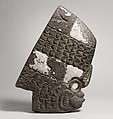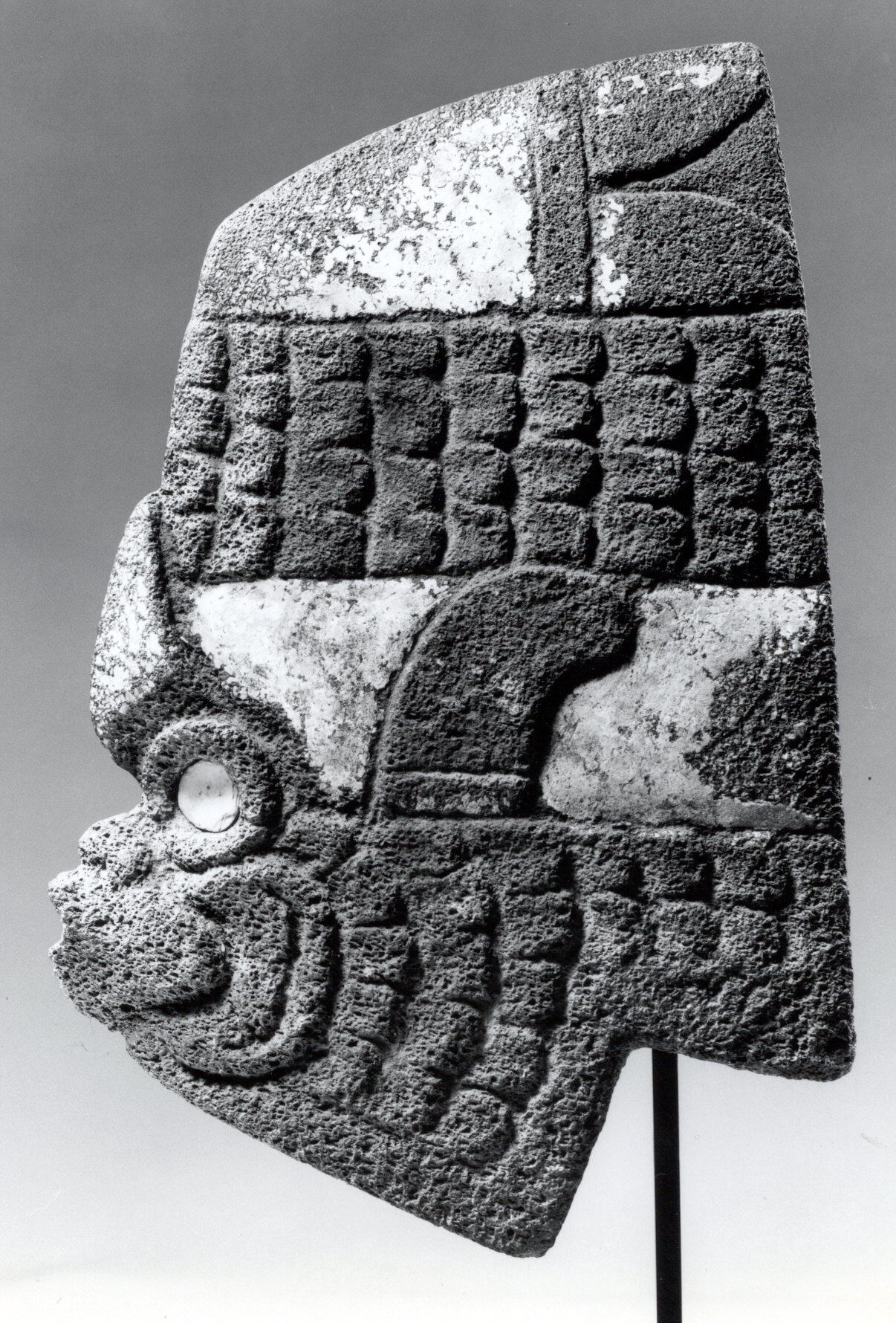Fish Hacha
Not on view
Mesoamerican ballplayers wore protective gear called hachas, palmas, and yokes to protect their hips and abdomens from the impact of the game’s solid rubber ball (see MMA 1978.412.15 and 1978.412.16). In painting and sculpture, the yoke is shown worn around the player’s hips, the palma or hacha attached at the front. Those used during active play were most likely made of wood or some other light material; stone versions such as this one were worn, if at all, during ballgame-related rituals, or placed on display. Given the distinctive design of each hacha, both those worn and those carved in stone may have served to identify teams or individuals.
Hachas also vary greatly in form and size, so much so that they qualify as a group only in contrast to the taller and thinner palmas. The Metropolitan’s own collection includes hachas in the form of human or animal heads, full figures, even one representing a pair of human hands. The name hacharefers to the axe-like form of many (hacha is Spanish for axe), including the example seen here. In these, the back is slightly wider than the front where the sides converge in a sharp point. Facial features and any other details are carved on low relief, each side a mirror image of the other.
In other ways this stone hacha is unusual in both its subject and composition. In order to conform to the classic hacha shape, the artist has rendered the face, body and tail fin in consecutive, ascending registers of low relief. This creative solution to the problem of representing a horizontal subject within the confines of the vertical hacha format does not preclude a closely observed, detailed rendering of the subject, however. The artist has carefully rendered each scale individually, with increased depth of relief from front to back, mimicking how fish fins overlap in nature. The rounded form of the cheeks, slightly open mouth, and flared gills suggest the respiration and movement of the fish as it passes through the water.
In jarring contrast to this naturalistic image is the fish’s unusual profile. The inclusion of what looks like a very human nose suggests a composite being of the supernatural realm. The belief in a watery underworld inhabited by deities was widespread throughout Mesoamerica. At the Classic Veracruz city of El Tajín, scenes of ballgame-related rituals both on earth and in the underworld are carved on the walls of one of its many ball courts. In one, a man wearing a fish helmet sits in a water-filled temple, surrounded by supernatural figures. The unusual blending of fish and human elements on this hacha may reflect the widespread Mesoamerican belief that the ball court was a conduit, the game and its rituals a way of connecting humans to the deities dwelling in that realm.
Patricia Joan Sarro, 2017
Published references
Art of Oceania, Africa, and the Americas from the Museum of Primitive Art. New York: The Metropolitan Museum of Art, 1969, fig. 584.
Resources and additional reading
Ceremonial Sculpture of Veracruz. New York: Long Island University, 1987.
Earley, Caitlin C. "The Mesoamerican Ballgame." In The Hilbrunn Timeline of Art History. New York: The Metropolitan Museum of Art, 2000–. http://www.metmuseum.org/toah/hd/mball/hd_mball.htm (June 2017)
Koontz, Rex. Lightning Gods and Feathered Serpent: The Public Sculpture of El Tajín. Austin: University of Texas Press, 2009.
Leyenaar, Ted J.J. Ulama, Jeu de Balle des Olmeques aux Azteques - Ballgame, from the Olmecs to the Aztecs. Lausanne: Musée Olympique, 1997.
The Metropolitan Museum of Art. Vol. 12, The Pacific Islands, Africa, and the Americas
Scott, John F. "Dressed to Kill: Stone Regalia of the Mesoamerican Ballgame". In The Sport of Life and Death, The Mesoamerican Ballgame, E. Michael Whittington, ed., pp. 50–63 New York: Thames and Hudson, 2001.
Shook, Edwin M. and Elayne Marquis. Secrets in Stone: Yokes, Hachas and Palmas from Southern Mesoamerica. Philadelphia: American Philosophical Society, 1996.
Von Winning, Hasso and Nelly Gutiérrez Solana. La Iconographía de la Cerámica de Río Blanco, Veracruz. Mexico City: UNAM Instituto de Investigaciones Estéticas, 1996.
Due to rights restrictions, this image cannot be enlarged, viewed at full screen, or downloaded.
This artwork is meant to be viewed from right to left. Scroll left to view more.



